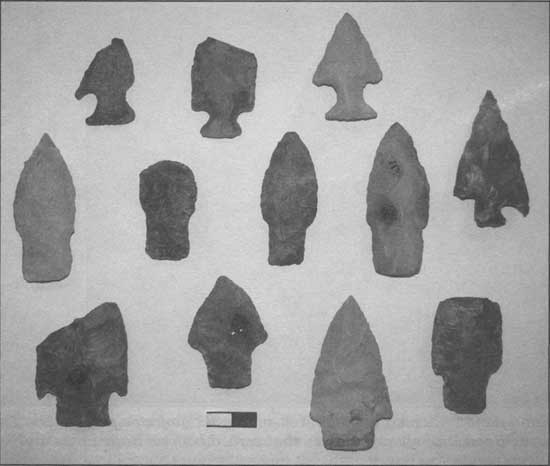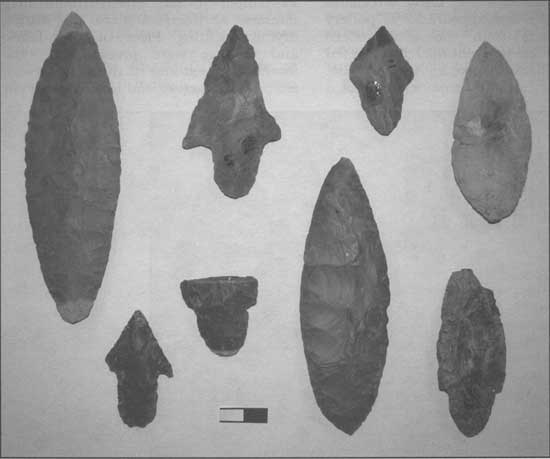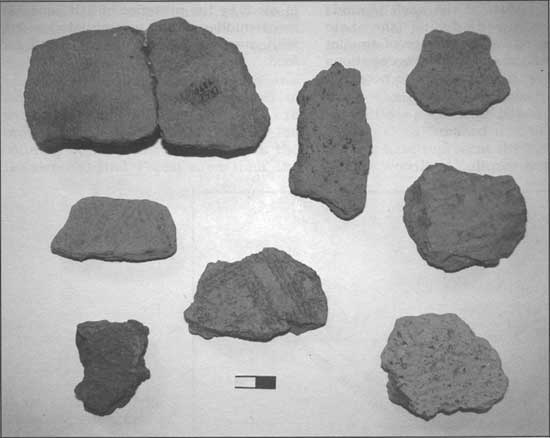|
Looking at Prehistory: Indiana's Hoosier National Forest Region, 12,000 B.C. to 1650 |

|
Looking at Prehistory:
Early Woodland Period 1,000 to 200 B.C.
Artifacts that pertain to this period include projectile points belonging to the Early Woodland Stemmed cluster, Dickson cluster, Motley cluster, and the straight stemmed types within the Saratoga cluster (Figure 64). There are many different Early Woodland cultures. A phenomenon that continues from the Late Archaic period is the making of cache blades made from Wyandotte chert. These were also distributed as trade commodities long distances from the Harrison County area in exchange for copper articles and other exotic raw materials and artifacts (Figure 65).

|
| Figure 64: Various Early Woodland period projectile points from sites in the hill country and beyond. |

|
| Figure 65: Early Woodland period Adena and other Dickson cluster projectile points. The unnotched specimens are Adena Leaf-shaped Blades that served both as trade items and preforms for making Adena points. |
The most important development that distinguishes the Early Woodland period is the first appearance of pottery that spreads from the southeastern United States to eventually be adopted by all prehistoric peoples in the East. The use of ceramic containers marks a revolution in storage and cooking technology that arrives in the Ohio Valley around 600 B.C. from the southeastern United States. Some local types of this pottery are known as Sugar Hill, Marion and Fayette Thick. These vessels were thick-walled, heavy and often had flat bottoms and a shape roughly like a flowerpot (Figure 66). These are only known from fragments because no whole vessels have been found anywhere in the Ohio Valley.

|
| Figure 66: Fragments of Early Woodland pottery from sites within the Hoosier National Forest and the Ohio Valley. These are cord-marked and fabric impressed. A few of these have different woven impressions on the interior and exterior sides. |
Local clay was collected and coarse stones including sandstone, limestone, quartz, rounded pebbles, and sometimes chert or flint were added to the wet clay as temper to add strength and help minimize shrinkage and cracking during drying and firing. Pieces of woven fabric and cordage were pressed into the interior and exterior of the vessel as an aid in manufacture and to help maintain the finished shape until the clay dried. The roughened surface may also have served as an aid in holding and moving the vessels after they were fired. These impressions of cords and fabrics are about the only surviving evidence of the weaving and cordage industries that no doubt existed as early as people set foot in North America. The woven fabrics and cords used to form pottery vessels were probably pieces of worn-out clothes and perhaps pieces of rugs and blankets that were re-used one final time before being thrown away. In just a few centuries, the use of cord impressions in various ways on the outside of ceramic vessels becomes a way of also decorating pottery.
Only a few pieces of interior and exterior cord and fabric marked pottery have been found at sites located in the Hoosier National Forest or at large base settlements up and down the Ohio Valley. This probably means only a few ceramic vessels were utilized while cooking and storing foods in a fashion much like previous people had done. This was a time before the making and using of pottery became a common practice. Evidence from sites within the Hoosier National Forest and elsewhere in southern Indiana indicates these people had home ranges extending at least several miles into the uplands for hunting and collecting away from the major stream valleys. Once a small number of the thick and heavy pottery vessels were carried up into the ravines and rockshelters, they probably stayed there until finally broken.
Early Woodland peoples in the central Ohio Valley were probably keeping some gardens in the summer months to cultivate preferred seed plants. The rockshelters within the Hoosier National Forest show substantial amounts of nut shells, indicating nut food was a mainstay along with the hunting of deer, turtles, turkeys, and some smaller animals. Occupations within the hill country were probably often for fall hunting and collecting although substantial numbers of turtle bones in the shelters also suggests the hill country was being used during other times of the year as well.
We know very little about the seasonal movements of these people, or how far from the Ohio Valley they may have traveled on a yearly cycle. We know little to nothing about the types of homes and shelters they used but we can assume they were not substantially different from earlier times. Refuse middens with the remains of numerous fires, pits, burials and trash accumulated over centuries has obscured the signs of architecture so we do not know if these were single family or multiple family dwellings, but both are likely.
While burial mounds constructed over former ceremonial structures are common over much of eastern Indiana and a much wider territory, no such constructions are known for the hill country. There are some reports of looted Adena culture mounds in Spencer and Harrison counties along the Ohio River close to the boundaries of the Hoosier National Forest and some may eventually be documented within the forest. The Adena culture is known from a site by that name in Ohio and was one of the first cultures to construct burial mounds with tombs and have elaborate ceremonies for the deceased.
Some of the larger Adena culture sites occur along the Ohio River near the Wyandotte chert source where this resource was heavily exploited for tools and leaf-shaped blades for trade outside the region. Both of these products of the flint-knapping arts were brought to sites in the Hoosier National Forest for use, as they were to other kinds of habitation sites up and down the Ohio River (see Figure 65). Most of the shell mounds formerly occupied during the Late Archaic period have evidence of smaller Early Woodland and later occupations associated with them. These occurred largely after the shell middens had already been accumulated. We do not know why later people were not as focused on mussel collecting. Did they prefer another type of meat or is there another reason for the change? Several factors together probably account for less mussel collecting. The rivers may have been depleted of mussels because of over-collecting in the Late Archaic period. Perhaps more importantly, the environment of the rivers, such as annual water level and biological factors, made it less likely for large colonies of mussels or shoals to be available for exploitation. Even so, evidence for the use of river resources and fishing certainly continues throughout the archaeological record. This is known not so much by the presence of fishing equipment but, when bone preservation is good, by the presence of fish bones in most middens that accumulated along with many species of animals used for food.
| <<< Previous | <<< Contents>>> | Next >>> |
|
9/hoosier/prehistory/sec5.htm Last Updated: 21-Nov-2008 |